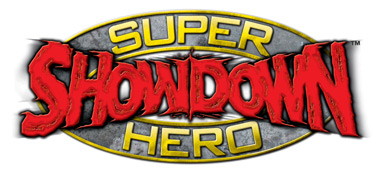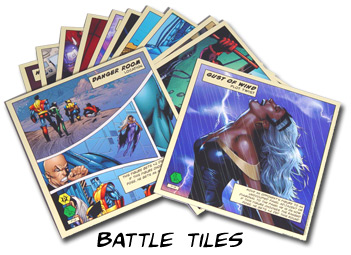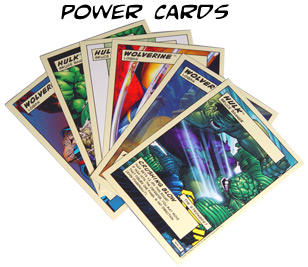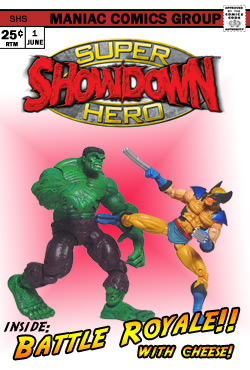
Super Hero Showdown:
The Game

As long as people have read comics, they have sparked debates. Sure, the way that characters seem to come back from the dead might inspire a philosophical discussion but when you get right down to it, the real issues involve a different kind of conflict. They are all about who can beat who, or to paraphrase - could Spider-Man beat Wolverine. The answer in comics is usually easy - whose book is it in. A new way to get an answer is through the Super Hero Showdown figures and game from Toy Biz and Upper Deck.
This certainly isn't the first game to let you use Marvel characters. Not counting the endless video games, you have the HeroClix game from Wiz Kids and the Marvel Super Heroes role-playing game. What's different here is that instead of pre-posed pieces or battles that take place in the imagination you use action figures in concert with some rules (and yes - dice) to resolve your issues.
To get a closer look at the figures, check out our companion Spotlight that focuses on just them. Check it out and we'll wait for you!
Now that you're back...

What's in the box?
You'll need a starter set to, umm, get started. Inside you get two figures (either Wolverine and Hulk or Thing and Spider-Man), 6 power cards (3 for each character), 2 power bases and 12 battle tile cards for the play area. Each figure has its own projectile and launcher for ranged attacks (the projectiles have fists on the end like the old boxing glove arrow). Last you get a set of rules to show you how to play the game.
For the single figure booster packs you get a little less and a little more. You get one figure (along with a projectile and launcher), 1 battle tile, 6 power cards and a cheat sheet with a basic summary of the rules. Three of the power cards are for the figure included and the other three are for other characters in the game.
Game Concepts
There are a few parts of the game that we should cover to make it easier to understand. There are four things that will be used to determine the outcome of the game - battle bases, power cards, battle tiles and the action figures.
The battle bases have attack and defense ratings on them and an embossed picture of the character. They also serve as stands for the action figures and let you put them in suspended poses using the included poseable mast.

The power cards are specific to a certain character and allow unique actions or let you modify your attack or defense ratings. They can only be used once in a game and are also used to keep track of how many hits you take.
Next are the battle tiles and they have two purposes. First they are the game board that you play on, and second they allow either modifying your attack and defense scores or they may have power-like effects. There are two kinds - location cards (like Muir Island) and plot twist cards. They can be used over and over if you end up on the same tile.
Last are the action figures. Not only do you move them around the board but you also have four poses that come into play during the game with different effects. The punch allows side-to-side attacks, and the kick diagonal attacks. The ranged attack lets you hit from a distance with the projectile launcher, but can generally only be used once. Last is the power pose that lets you use either powers or some battle tile abilities. The power pose is very free-form so you can pose the figure however you would like.
Lest we forget, there are two dice. Most people need no further explanation, but for the geeks they are six-sided dice. For the even more geeky, they are cubes and one of Pythagoras' perfect solids. If you can name the other four solids, that's very nice for you...
The Game
The game isn't overly complex and even at the highest level (4) it is still more a 'beer and pretzels' game than anything deep and complex where you'll need books, charts and computers. The game is broken into 4 levels of play, and they add more concepts and layers of complexity as you go. The full rules are available in the starter sets but we'll summarize the four modes of game play.
Before the levels comes the very heart of the game - determining hits. Each player gets 3 hits per character and when you take all your opponent's away you win. The formula is simple - attack rating plus result of rolling both dice compared with defense rating plus roll of two dice. If the attack number is higher you get a hit, though powers and battle tiles can influence ratings and even heal hits.
Level one is pretty simple and can be played right out of the box. The characters can punch, kick and shoot each other as well as utilize their powers (as listed on their power cards). You move, you fight and eventually someone wins. Pretty simple.
Level two adds in the battle tiles. Each of the tiles has either a situation or an area familiar to comics fans, and these cards then modify the characters during the battle based on pose. This just adds some depth and makes certain spots more advantageous and helps to randomize the game. It also gives you a good reason to keep moving.
Level three makes the power cards hidden, so now you won't know what to expect from your opponent during the fight (making it harder to counter potential moves). Otherwise, this is the same as level two.
Level four is all about adding more than two characters to the mix. It involves battles with groups and/or more than two players. You can either have group battles or fight a deathmatch-like free for all. It even includes rules for a 'king of the hill' game where one player battles all comers to see who can be king of the hill.
You'll need to get more than one starter set to play the larger 'level four' battles simply because you won't have enough battle tiles for the larger game board.
One important thing about the way the game is played is that you could use other figures instead of the ones included while using the bases from the game. All you really need is a figure that can be posed, the battle base and the powers cards and tiles to play. However, space could be an issue for larger figures if you choose to use them.
The game itself was created and developed by Upper Deck.

The Demo
What better way to check out the game than to see a short demo of a battle? Click on the comic cover for an exclusive issue of Super Hero Showdown giving you the feel and flavor of the game. Don't worry about being able to read the cards or understand everything about the rules, but take a chance to get a feel for the flow of play.
The demonstration uses the level two rules, so the battle tiles come into play during the game. There is a small grid on the panels to help you see where the figures have moved on the board and the descriptions are simplified.
Why You'll Want to Buy them
The game itself isn't overly complex and can be played quickly. It is easy to learn for younger players and it also encourages actual play with the action figures along with the game, and coming up with different poses can require creative thinking.
The game should be easy to learn for younger players and you can add complexity as they get more comfortable with the rules and how to play. And anything that keeps your kids quiet for a few hours is worth its weight in gold!
|









